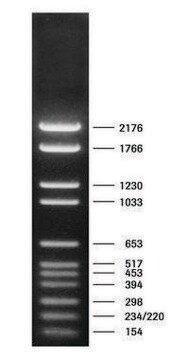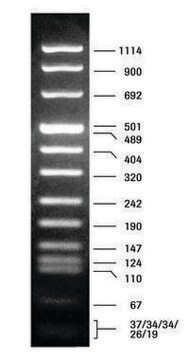Wichtige Dokumente
11218611910
Roche
DNA Molecular Weight Marker VI, DIG-labeled
solution, pkg of 500 μL (10 μg/ml)
Synonym(e):
DNA marker
About This Item
Empfohlene Produkte
Form
solution
Qualitätsniveau
Verpackung
pkg of 500 μL (10 μg/ml)
Hersteller/Markenname
Roche
Grünere Alternativprodukt-Eigenschaften
Designing Safer Chemicals
Learn more about the Principles of Green Chemistry.
sustainability
Greener Alternative Product
Grünere Alternativprodukt-Kategorie
Lagertemp.
−20°C
Allgemeine Beschreibung
Anwendung
Komponenten
Sequenz
Note: Fragment lengths are derived from computer analysis of the DNA sequence. Depending on the size range of the marker, the smallest fragments will only be visible on overloaded gels.
Sonstige Hinweise
Fragment lengths are derived from computer analysis of the DNA sequence. Depending on the size range of the marker, the smallest fragments will only be visible on overloaded gels.
Lagerklassenschlüssel
12 - Non Combustible Liquids
WGK
nwg
Flammpunkt (°F)
No data available
Flammpunkt (°C)
No data available
Hier finden Sie alle aktuellen Versionen:
Besitzen Sie dieses Produkt bereits?
In der Dokumentenbibliothek finden Sie die Dokumentation zu den Produkten, die Sie kürzlich erworben haben.
Kunden haben sich ebenfalls angesehen
Artikel
Digoxigenin (DIG) labeling methods and kits for DNA and RNA DIG probes, random primed DNA labeling, nick translation labeling, 5’ and 3’ oligonucleotide end-labeling.
Global Trade Item Number
| SKU | GTIN |
|---|---|
| 11218611910 | 4061838699787 |
Unser Team von Wissenschaftlern verfügt über Erfahrung in allen Forschungsbereichen einschließlich Life Science, Materialwissenschaften, chemischer Synthese, Chromatographie, Analytik und vielen mehr..
Setzen Sie sich mit dem technischen Dienst in Verbindung.






